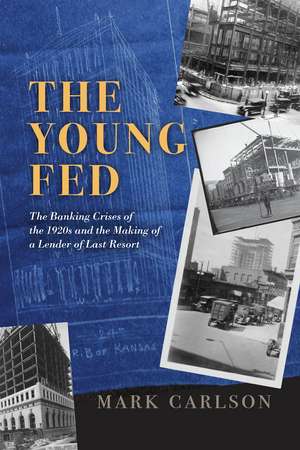The Young Fed: The Banking Crises of the 1920s and the Making of a Lender of Last Resort: Markets and Governments in Economic History
Autor Mark Carlsonen Limba Engleză Hardback – 23 ian 2025
The long-standing description of the Federal Reserve as a “lender of last resort” refers to the central bank’s emergency liquidity provision for financial entities in periods of crisis. As Mark Carlson shows, this function was foundational to how the Fed was designed but has, at times, proven challenging to implement. The Young Fed examines the origins of the Federal Reserve’s emergency liquidity provision which, along with the setting of monetary policy, has become a critical responsibility.
Focusing on the Fed’s response to the financial crises of the 1920s, Carlson documents the formative deliberations of central bank policymakers regarding how to assist banks experiencing distress; the lessons that were learned; and how those lessons shaped subsequent policies. Carlson depicts an early Fed that experimented with a variety of approaches to crises, ranging from bold spectacles featuring cash-filled armored cars to behind-the-scenes interventions to prevent inducing panics or bank runs. The Young Fed weaves previously unpublished material from the Fed archives into a watershed work in American economic history: a deeply sourced account of how the world’s most important central bank became a lender of last resort.
Preț: 286.83 lei
Nou
Puncte Express: 430
Preț estimativ în valută:
54.88€ • 59.81$ • 46.25£
54.88€ • 59.81$ • 46.25£
Carte disponibilă
Livrare economică 02-16 aprilie
Preluare comenzi: 021 569.72.76
Specificații
ISBN-13: 9780226837826
ISBN-10: 0226837823
Pagini: 240
Ilustrații: 1 halftones, 11 line drawings, 14 tables
Dimensiuni: 152 x 229 x 20 mm
Greutate: 0.38 kg
Ediția:First Edition
Editura: University of Chicago Press
Colecția University of Chicago Press
Seria Markets and Governments in Economic History
ISBN-10: 0226837823
Pagini: 240
Ilustrații: 1 halftones, 11 line drawings, 14 tables
Dimensiuni: 152 x 229 x 20 mm
Greutate: 0.38 kg
Ediția:First Edition
Editura: University of Chicago Press
Colecția University of Chicago Press
Seria Markets and Governments in Economic History
Notă biografică
Mark Carlson is an economist and advisor for the Board of Governors of the US Federal Reserve System in Washington, DC.
Cuprins
Acknowledgments
List of Figures and Tables
Chapter 1. Introduction
Chapter 2. Background on the 1920s, the Banking System, and the Federal Reserve
Chapter 3. Tools to Respond to Financial Stress
Chapter 4. Philosophy Regarding Emergency Liquidity Support
Chapter 5. Case Studies of Federal Reserve Interventions
Chapter 6. The Experience of the Early 1920s and Changes in Lending Policies
Chapter 7. Parallels to Modern Times and Lessons for Today
Chapter 8. Conclusion
Appendix 1. Episodes of Emergency Liquidity Provision in the United States Prior to the Federal Reserve
Appendix 2. Subsequent Use of Currency Funds
Appendix 3. Federal Reserve and OCC Officials
Appendix 4. Actions by FRB Atlanta during the Early 1920s in a More Macroeconomic Context
Notes
References
Index
List of Figures and Tables
Chapter 1. Introduction
Chapter 2. Background on the 1920s, the Banking System, and the Federal Reserve
Chapter 3. Tools to Respond to Financial Stress
Chapter 4. Philosophy Regarding Emergency Liquidity Support
Chapter 5. Case Studies of Federal Reserve Interventions
Chapter 6. The Experience of the Early 1920s and Changes in Lending Policies
Chapter 7. Parallels to Modern Times and Lessons for Today
Chapter 8. Conclusion
Appendix 1. Episodes of Emergency Liquidity Provision in the United States Prior to the Federal Reserve
Appendix 2. Subsequent Use of Currency Funds
Appendix 3. Federal Reserve and OCC Officials
Appendix 4. Actions by FRB Atlanta during the Early 1920s in a More Macroeconomic Context
Notes
References
Index
Recenzii
"The Federal Reserve we know is the mature, dollar-spinning behemoth that holds short-term interest rates in the hollow of its hand. The Young Fed is the central bank’s coming-of-age story. . . .A formidable history."
“A pathbreaking book on central banking history, The Young Fed is the first detailed account of the mechanisms, motivations, and internal deliberations of the various Federal Reserve Banks during their formative first years. Written by a brilliant banking economist and financial historian, The Young Fed integrates sophisticated economic analysis with narrative, insightfully informing the discussion of central banking’s past.”
“The Federal Reserve was created to serve as a lender of last resort for the financial system of the United States. For over a century, the Fed has struggled to balance multiple objectives and challenges of this role. Mark Carlson, a leading scholar on this topic, has written a terrific book showing how we can trace this struggle back to the beginning, with fascinating case studies of the Fed’s decisions about emergency lending in the 1920s.”








